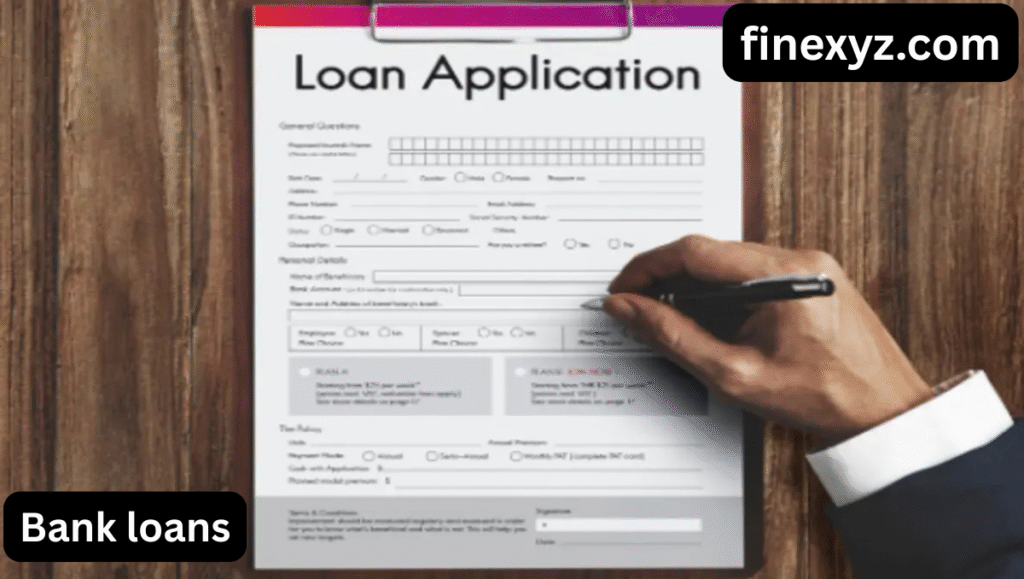Bank loans are an excellent method to fund large expenditures, but understanding how they work is critical. In this article, we’ll go over everything you need to know about bank loans, including types and eligibility, interest rates, and payback lengths. We can help you manage the process of getting a personal loan, mortgage, vehicle loan, or small business loan. Learn how to find the correct loan, get accepted, and obtain the greatest deal for your financial goals in 2025.
What are bank loans?
A bank loan is a quantity of money borrowed from a financial organisation, such as a bank or credit union, with the agreement to repay it over a set time period. Loans often have an interest rate—essentially the cost of borrowing the money—and payback terms can range from a few months to several years.
When you take out a loan, you have to repay it in installments. These payments often include both the loan amount (principal) and interest. The amount of interest you pay is determined by the interest rate agreed upon when you took out the loan.
Types of Bank Loans
There are various types of bank loans, each tailored to satisfy a certain financial requirement. Understanding these loan types might help you decide which one is right for you.
1. Personal Loans.
Personal loans are usually unsecured, which means you don’t have to provide any collateral (such as your home or car) to secure the loan. These loans can be used for a variety of reasons, including debt consolidation, medical costs, and home improvements. Personal loans, which do not require collateral, may have higher interest rates than secured loans.
2. Home loans (mortgage loans).
Home loans are used just to acquire a property or home. These loans are secured by the property you are purchasing, which means the bank has the right to acquire ownership if you fail to repay the debt. Mortgages often have lower interest rates than personal loans because they are secured loans.
There are two types of mortgage loans: fixed-rate mortgages and adjustable-rate mortgages (ARMs). A fixed-rate mortgage keeps the same interest rate throughout the loan term, whereas an adjustable-rate mortgage (ARM) might change after a specified period.
3. Car loans
Car loans are intended to help you buy a vehicle. These loans, like mortgage loans, are secured, which means the car is used as collateral. If you fail to make your loan installments, the bank may repossess your vehicle. Car loans often have set interest rates, making it easier to budget your payments.
4. Business Loans.
If you’re a business owner trying to expand, buy equipment, or cover operational expenses, you may require a business loan. These loans might be secured or unsecured, depending on the amount and bank regulations. Business loans have different interest rates and periods, so it’s crucial to search around for the best deal.
5. Student Loans
Student loans are intended to help cover the costs of education. These loans frequently have cheaper interest rates and more flexible repayment terms. Some student loans may even provide deferred repayment, which means you don’t have to begin repaying until after graduation.

How Do Bank Loans Work?
Now that we’ve discussed the various forms of loans, let’s look at how they work.
1. Application Process
The first step in obtaining a bank loan is the application process. This entails submitting a loan application form to the bank, along with any supporting papers. To determine your ability to repay the loan, the bank will normally request information about your income, occupation, and any current debts.
2. Loan Approval.
After you submit your application, the bank will look into your financial history and credit score. If you have a good credit score and a solid financial history, your chances of getting approved for a loan are better. If you have a low credit score, the bank may request a cosigner or collateral to obtain the loan.
3. Interest Rates.
Interest rates are one of the most essential considerations when applying for a loan. The interest rate decides how much you’ll pay in addition to the loan balance over time. There are two primary types of interest rates:
- Fixed Interest Rates: The interest rate remains constant during the loan tenure.
- Variable Interest Rate: The interest rate fluctuates over time, based on market conditions.
When applying for a loan, be sure to question the bank about the interest rate and how it will effect your payments.
4. Repayment Terms
Once your loan is accepted, the bank will explain the repayment conditions. These include the loan amount, interest rate, and loan repayment period (term). Monthly installments are typically set up to ensure that you repay the loan before the end of the period.
How to Find the Best Deal on a Bank Loan
Getting a bank loan can be an excellent way to fund significant expenditures or investments. However, you should always try to acquire the greatest possible offer. Here are a few suggestions to help you do that:
1. Check your credit score.
Your credit score has a huge impact on whether or not you will be approved for a loan and what interest rate you will pay. A higher credit score typically results in a reduced interest rate, which can save you a significant amount of money over time.
Before asking for a loan, be sure your credit score is in good shape. If it is lower than you would want, consider improving it before applying.
2. Shop around.
varying banks and financial institutions have varying terms and interest rates, so shop around. Compare offers from several banks, taking into account both interest rates and repayment periods.
3. Consider the loan term.
The loan term is the amount of time you have to repay the loan. While a longer term may result in lower monthly payments, it may also mean paying more interest over time. A shorter term may result in larger monthly payments, but you will pay off the loan faster and with less interest. Select a loan term that suits your financial circumstances.
4. Understand the Fees.
Some loans have additional expenses, such as origination fees, late payment fines, or early repayment penalties. Make sure to ask the bank about any loan fees so you can make an informed decision.
5. Consider your ability to repay.
Before taking out any loan, you should consider your ability to repay it. Consider your existing financial condition and whether you’ll be able to make the monthly installments without exceeding your budget.

Conclusion
Bank loans are an important financial tool that can help you achieve your goals, such as purchasing a home, financing your school, or expanding your business. Understanding the many types of loans available, how they function, and how to get the best deal allows you to make informed decisions that will benefit you in the long run.
Read more
FAQ:
1. What is a bank loan?
A bank loan is borrowed money that must be paid back with interest. It can be used for a variety of objectives, including housing and business purchases.
2: How can I qualify for a bank loan?
You must have a strong credit score, a consistent income, and a modest debt-to-income ratio. Banks examine your ability to repay a loan.
3. What is the distinction between a secured and an unsecured loan?
Secured loans require collateral, whereas unsecured loans do not. Secured loans usually have lower interest rates.
4: What factors influence interest rates on bank loans?
Interest rates vary according to your credit score, loan type, and market conditions. Rates are normally cheaper for those with better credit ratings.
5: Can I repay my bank loan early?
Yes, most loans allow for early repayment, however some require a fee. Paying your bills ahead of time can help you save money on interest.

3 thoughts on “How to Get a Bank Loan in 2025.”